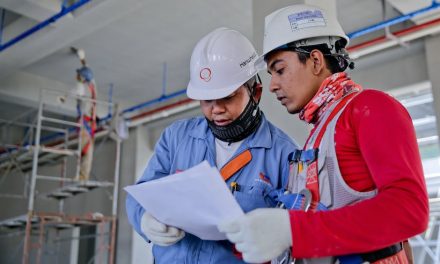Table of Contents
- Introduction
- The Importance of Setting Clear Goals and Expectations for Employees
- Strategies for Developing and Nurturing Employee Skills and Competencies
- Effective Communication Techniques for Enhancing Employee Engagement and Collaboration
- Implementing Continuous Improvement Initiatives to Drive Operational Excellence and Employee Growth
- Q&A
- Conclusion
Achieving Operational Excellence while Balancing Employee Growth: The Essential Plan for Managers
Introduction
Achieving operational excellence while balancing employee growth is a crucial goal for managers in today’s dynamic business environment. In order to drive organizational success, managers must develop an essential plan that focuses on optimizing operational processes while simultaneously nurturing the growth and development of their employees. This approach ensures that the organization operates efficiently and effectively, while also fostering a positive and engaging work environment that promotes employee satisfaction and productivity. By striking the right balance between operational excellence and employee growth, managers can create a sustainable and thriving organization that is well-positioned for long-term success.
The Importance of Setting Clear Goals and Expectations for Employees

Achieving operational excellence is a key goal for any organization. It involves optimizing processes, reducing waste, and improving efficiency to deliver high-quality products or services. However, achieving operational excellence should not come at the expense of employee growth and development. Managers play a crucial role in balancing these two objectives, and one essential aspect of this is setting clear goals and expectations for employees.
Setting clear goals and expectations is vital for several reasons. Firstly, it provides employees with a clear understanding of what is expected of them. When employees know what is expected, they can align their efforts and focus on the right priorities. This clarity helps to minimize confusion and reduces the chances of employees wasting time and effort on tasks that are not aligned with organizational goals.
Secondly, setting clear goals and expectations helps to foster accountability. When employees have a clear understanding of what they need to achieve, they can take ownership of their work and be held accountable for their performance. This accountability drives employees to strive for excellence and ensures that they are actively working towards the organization’s objectives.
Furthermore, clear goals and expectations provide a basis for performance evaluation and feedback. When managers have a clear set of goals and expectations, they can objectively assess employee performance and provide constructive feedback. This feedback is crucial for employee growth and development, as it helps them understand their strengths and areas for improvement. By providing regular feedback, managers can guide employees towards achieving their goals and help them develop the necessary skills and competencies.
To set clear goals and expectations, managers should follow a systematic approach. Firstly, they need to ensure that goals are specific, measurable, achievable, relevant, and time-bound (SMART). Specific goals provide clarity on what needs to be achieved, while measurable goals allow for objective evaluation. Achievable goals ensure that employees are not overwhelmed or demotivated, while relevant goals align with the organization’s overall objectives. Lastly, time-bound goals provide a sense of urgency and help employees prioritize their tasks.
In addition to setting SMART goals, managers should also communicate expectations clearly. This involves explaining the desired outcomes, performance standards, and any specific guidelines or procedures that need to be followed. Managers should also encourage employees to ask questions and seek clarification if they are unsure about any aspect of their goals or expectations. This open communication ensures that employees have a clear understanding of what is expected and reduces the chances of misunderstandings or misinterpretations.
Moreover, managers should regularly review and update goals and expectations as needed. As organizational priorities change or new challenges arise, it is essential to adapt goals and expectations accordingly. Regularly reviewing goals also allows managers to assess progress and make any necessary adjustments to ensure that employees stay on track.
In conclusion, setting clear goals and expectations is crucial for achieving operational excellence while balancing employee growth. Clear goals provide employees with a sense of direction and accountability, while expectations help guide their efforts. By following a systematic approach and communicating expectations clearly, managers can ensure that employees understand what is expected of them and can work towards achieving their goals. Regularly reviewing and updating goals also allows for flexibility and ensures that employees stay aligned with organizational objectives. Ultimately, this balance between operational excellence and employee growth is essential for the long-term success of any organization.
Strategies for Developing and Nurturing Employee Skills and Competencies
Achieving operational excellence is a goal that many managers strive for in their organizations. However, it is equally important to balance this pursuit with the growth and development of employees. After all, employees are the backbone of any organization and their skills and competencies play a crucial role in achieving operational excellence. In this article, we will explore strategies that managers can employ to develop and nurture employee skills and competencies.
One of the most effective strategies for developing employee skills and competencies is through training and development programs. These programs can take various forms, such as workshops, seminars, or online courses. By providing employees with opportunities to learn and acquire new skills, managers can ensure that they are equipped to handle the challenges of their roles. Additionally, training and development programs can also help employees stay up-to-date with the latest industry trends and best practices, further enhancing their competencies.
Another strategy for nurturing employee skills and competencies is through mentorship programs. Pairing employees with experienced mentors can provide them with valuable guidance and support. Mentors can share their knowledge and expertise, helping employees develop new skills and competencies. Moreover, mentorship programs can also foster a sense of belonging and engagement among employees, as they feel supported and valued by their mentors.
In addition to training and mentorship programs, managers can also encourage continuous learning within their organizations. This can be achieved by creating a culture of learning, where employees are encouraged to seek out new knowledge and skills. Managers can provide resources such as books, articles, or online courses, and allocate time for employees to engage in self-directed learning. By promoting a culture of continuous learning, managers can ensure that employees are constantly growing and developing their skills and competencies.
Furthermore, managers can also facilitate cross-functional collaboration and knowledge sharing within their organizations. By encouraging employees from different departments or teams to work together on projects or initiatives, managers can create opportunities for employees to learn from each other. This can lead to the exchange of ideas, best practices, and different perspectives, ultimately enhancing the skills and competencies of all involved.
Lastly, managers should also provide regular feedback and performance evaluations to employees. This feedback should not only focus on areas for improvement but also highlight and recognize employees’ strengths and achievements. By providing constructive feedback, managers can help employees identify areas where they can further develop their skills and competencies. Additionally, recognizing and celebrating employees’ accomplishments can boost their morale and motivation, further fueling their growth and development.
In conclusion, achieving operational excellence while balancing employee growth is essential for managers. By implementing strategies such as training and development programs, mentorship programs, fostering a culture of continuous learning, facilitating cross-functional collaboration, and providing regular feedback, managers can develop and nurture employee skills and competencies. By investing in their employees’ growth and development, managers can create a workforce that is not only highly skilled but also motivated and engaged, ultimately leading to operational excellence.
Effective Communication Techniques for Enhancing Employee Engagement and Collaboration
Effective Communication Techniques for Enhancing Employee Engagement and Collaboration
In today’s fast-paced and competitive business environment, achieving operational excellence is crucial for the success of any organization. However, it is equally important for managers to balance this goal with the growth and development of their employees. By implementing effective communication techniques, managers can enhance employee engagement and collaboration, leading to improved productivity and overall organizational success.
One of the key communication techniques that managers can utilize is active listening. Active listening involves fully focusing on and understanding what the speaker is saying, without interrupting or formulating a response prematurely. By actively listening to their employees, managers can demonstrate that they value their input and opinions, which in turn fosters a sense of trust and respect. This open and honest communication environment encourages employees to share their ideas and concerns, leading to increased engagement and collaboration.
Another important communication technique is providing regular feedback. Employees need to know how they are performing and where they can improve. By providing constructive feedback, managers can help employees understand their strengths and weaknesses, and guide them towards professional growth. Regular feedback sessions also provide an opportunity for managers to recognize and appreciate their employees’ efforts, which boosts morale and motivation. This positive reinforcement encourages employees to continue working towards operational excellence while feeling valued and supported.
In addition to active listening and feedback, effective communication also involves setting clear expectations and goals. When employees have a clear understanding of what is expected of them, they are more likely to be engaged and motivated to achieve those goals. Managers should communicate these expectations clearly and consistently, ensuring that employees have the necessary resources and support to meet them. By aligning individual goals with the overall organizational objectives, managers can foster a sense of purpose and collaboration among employees.
Furthermore, managers should encourage open and transparent communication channels within the organization. This can be achieved through regular team meetings, one-on-one discussions, and the use of technology platforms that facilitate communication and collaboration. By creating an environment where employees feel comfortable expressing their ideas and concerns, managers can tap into the collective knowledge and creativity of their teams. This open communication culture also helps in identifying and resolving any issues or conflicts that may arise, leading to a more harmonious and productive work environment.
Lastly, managers should lead by example when it comes to effective communication. They should demonstrate active listening, provide regular feedback, and communicate openly and transparently with their employees. By modeling these behaviors, managers set the tone for the entire organization and encourage others to follow suit. When employees see their managers actively engaging in effective communication, they are more likely to adopt these practices themselves, leading to improved collaboration and overall organizational success.
In conclusion, achieving operational excellence while balancing employee growth requires effective communication techniques. By actively listening, providing regular feedback, setting clear expectations, encouraging open communication channels, and leading by example, managers can enhance employee engagement and collaboration. These communication techniques foster a positive work environment where employees feel valued, supported, and motivated to achieve operational excellence. Ultimately, this leads to improved productivity, innovation, and overall organizational success.
Implementing Continuous Improvement Initiatives to Drive Operational Excellence and Employee Growth
Achieving Operational Excellence while Balancing Employee Growth: The Essential Plan for Managers
In today’s competitive business landscape, organizations are constantly striving to achieve operational excellence. This involves optimizing processes, reducing waste, and improving efficiency to deliver high-quality products and services. However, it is equally important for managers to balance this pursuit of operational excellence with the growth and development of their employees. After all, a company’s success ultimately depends on the skills, motivation, and engagement of its workforce.
Implementing continuous improvement initiatives is a key strategy for driving both operational excellence and employee growth. By continuously evaluating and refining processes, organizations can identify areas for improvement and implement changes that lead to increased efficiency and productivity. This not only benefits the bottom line but also provides employees with opportunities to learn and grow.
One of the first steps in implementing continuous improvement initiatives is to establish a culture of innovation and learning within the organization. This involves creating an environment where employees feel empowered to suggest and implement improvements. Managers should encourage open communication and provide the necessary resources and support for employees to experiment with new ideas and approaches.
Regular training and development programs are also essential for fostering employee growth. By investing in their employees’ skills and knowledge, managers can ensure that they have the tools and capabilities to contribute to operational excellence. This can include technical training, leadership development, and cross-functional learning opportunities. By providing employees with the necessary training and development opportunities, managers can not only enhance their skills but also increase their job satisfaction and engagement.
Another important aspect of implementing continuous improvement initiatives is the use of data and analytics. By collecting and analyzing data on key performance indicators, managers can gain insights into areas that require improvement. This data-driven approach allows organizations to make informed decisions and prioritize initiatives that will have the greatest impact on operational excellence and employee growth. Additionally, by involving employees in the data collection and analysis process, managers can foster a sense of ownership and accountability.
To ensure the success of continuous improvement initiatives, it is crucial for managers to provide ongoing feedback and recognition to their employees. Regular performance evaluations and constructive feedback help employees understand their strengths and areas for improvement. By recognizing and rewarding employees’ contributions to operational excellence, managers can motivate and inspire them to continue their growth and development.
Furthermore, managers should also encourage collaboration and teamwork among employees. By fostering a culture of collaboration, employees can learn from each other’s experiences and expertise. This not only enhances operational excellence but also promotes employee growth by providing opportunities for knowledge sharing and skill development.
In conclusion, achieving operational excellence while balancing employee growth requires a strategic and holistic approach. By implementing continuous improvement initiatives, organizations can optimize processes and drive efficiency, while also providing employees with opportunities to learn and grow. This involves establishing a culture of innovation and learning, investing in training and development programs, using data and analytics to drive decision-making, providing ongoing feedback and recognition, and fostering collaboration and teamwork. By following this essential plan, managers can create a workplace that achieves operational excellence while nurturing the growth and development of their employees.
Q&A
1. What is operational excellence?
Operational excellence refers to the continuous improvement of processes and systems within an organization to achieve maximum efficiency, productivity, and quality.
2. How can operational excellence be achieved?
Operational excellence can be achieved by implementing strategies such as lean management, Six Sigma, process automation, and continuous improvement initiatives. It involves streamlining operations, eliminating waste, optimizing resources, and fostering a culture of innovation and collaboration.
3. Why is employee growth important in achieving operational excellence?
Employee growth is crucial in achieving operational excellence as it empowers employees to develop new skills, enhance their knowledge, and take ownership of their work. Engaged and motivated employees contribute to improved productivity, innovation, and overall organizational success.
4. How can managers balance employee growth with achieving operational excellence?
Managers can balance employee growth with achieving operational excellence by providing training and development opportunities, setting clear performance expectations, fostering a supportive work environment, and recognizing and rewarding employee achievements. It is important to align individual growth with organizational goals and ensure that employees have the necessary resources and support to excel in their roles.
Conclusion
In conclusion, achieving operational excellence while balancing employee growth is crucial for managers. By implementing an essential plan, managers can create a harmonious work environment that promotes both efficiency and employee development. This involves setting clear goals, providing adequate training and resources, fostering open communication, recognizing and rewarding employee achievements, and continuously evaluating and improving processes. By striking a balance between operational excellence and employee growth, managers can drive organizational success and create a motivated and engaged workforce.




